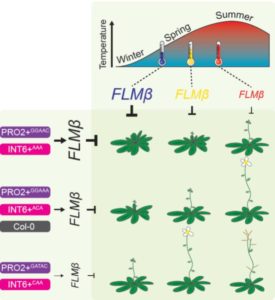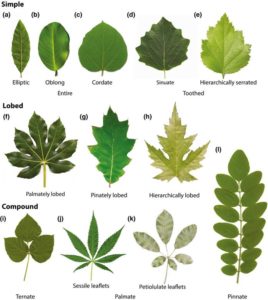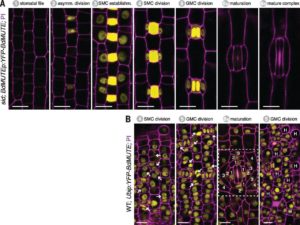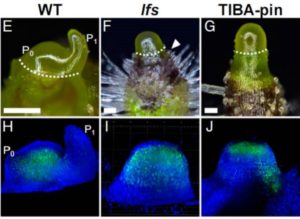Natural haplotypes of FLM non-coding sequences fine-tune flowering time in two ambient spring temperatures in Arabidopsis
 Delaying reproduction until conditions are favorable is a key to success. FLOWERING LOCUS C is a well-known regulator of flowering that delays flowering until after winter vernalization. In the spring, FLOWERING LOCUS M (FLM) fine-tunes flowering time in response to ambient temperatures between 5ºC and 23ºC. Lutz et al. found that the expression level of FLM is temperature dependent and that allelic variants in the promoter and intron that affect expression level are found in Arabidopsis accessions originating from different parts of Europe. Furthermore, when introduced into transgenic plants, these natural variants recapitulated their effects on FLM expression and flowering time. eLIFE 10.7554/eLife.22114
Delaying reproduction until conditions are favorable is a key to success. FLOWERING LOCUS C is a well-known regulator of flowering that delays flowering until after winter vernalization. In the spring, FLOWERING LOCUS M (FLM) fine-tunes flowering time in response to ambient temperatures between 5ºC and 23ºC. Lutz et al. found that the expression level of FLM is temperature dependent and that allelic variants in the promoter and intron that affect expression level are found in Arabidopsis accessions originating from different parts of Europe. Furthermore, when introduced into transgenic plants, these natural variants recapitulated their effects on FLM expression and flowering time. eLIFE 10.7554/eLife.22114


 The plethora of diverse leaf shapes results from variations of shared molecular mechanisms that govern leaf growth and development. To better understand the molecular underpinnings of diverse leaf morphologies, Runions et al. constructed a computational model of leaf development that included multiple parameters from prior inferences, molecular data and previous computational models. Factoring in mathematical representations of actively growing leaves, the action of morphogens such as CUS2, PIN1 and auxin at leaf margins, and the contribution of the vascular system into the computational model, the authors were able to construct a model that accurately reflects a diverse array of leaf morphologies. The authors propose that patterns of leaf development emerge from a self-organizing process that is characterized by several feed-back loops; by slightly tweaking the self-organizing process, the authors were able to produce drastically distinct leaf shapes. Future directions include factoring in detailed multi-scale analysis of actively growing leaves and including curved and folded leaves. (Summary by
The plethora of diverse leaf shapes results from variations of shared molecular mechanisms that govern leaf growth and development. To better understand the molecular underpinnings of diverse leaf morphologies, Runions et al. constructed a computational model of leaf development that included multiple parameters from prior inferences, molecular data and previous computational models. Factoring in mathematical representations of actively growing leaves, the action of morphogens such as CUS2, PIN1 and auxin at leaf margins, and the contribution of the vascular system into the computational model, the authors were able to construct a model that accurately reflects a diverse array of leaf morphologies. The authors propose that patterns of leaf development emerge from a self-organizing process that is characterized by several feed-back loops; by slightly tweaking the self-organizing process, the authors were able to produce drastically distinct leaf shapes. Future directions include factoring in detailed multi-scale analysis of actively growing leaves and including curved and folded leaves. (Summary by  Plants breathe through pores called stomata on leaf surfaces. Stomata are the point of contact with the outside world as they allow gas exchange (e.g., CO2 for photosynthesis) and transpiration. Grasses have evolved to form more efficient stomata in which the guard cells are flanked by additional subsidiary cells. Therefore, grasses form superior 4-celled stomata for efficient functioning; stomata can open wider or close faster in response to varying conditions. Starting with a loss-of-function mutant subsidiary cell identity defective (sid), Raissig et al. describe how in the model grass Brachypodium distachyon a transcription factor called MUTE physically moves from guards cells to adjacent cells to recruit them for formation of the 4-celled stomata complex. The corresponding MUTE protein from Arabidopsis does not move between cells and fails to rescue the loss-of-function sid mutant. (Summary by
Plants breathe through pores called stomata on leaf surfaces. Stomata are the point of contact with the outside world as they allow gas exchange (e.g., CO2 for photosynthesis) and transpiration. Grasses have evolved to form more efficient stomata in which the guard cells are flanked by additional subsidiary cells. Therefore, grasses form superior 4-celled stomata for efficient functioning; stomata can open wider or close faster in response to varying conditions. Starting with a loss-of-function mutant subsidiary cell identity defective (sid), Raissig et al. describe how in the model grass Brachypodium distachyon a transcription factor called MUTE physically moves from guards cells to adjacent cells to recruit them for formation of the 4-celled stomata complex. The corresponding MUTE protein from Arabidopsis does not move between cells and fails to rescue the loss-of-function sid mutant. (Summary by  Many of the genes involved in the phosphate-stress response (PSR) have been identified from plants growing on sterile medium. Castrillo et al. examined how the root microbiota affectthe phosphate stress response, and how phosphate affects the association between roots and microbes. Plants deficient in the PSR failed to assemble wild-type microbiota, indicating that the PSR influences the composition of root microbiota. Furthermore, the transcription factor PHR1, a master regulator of PSR, also regulates several plant immune system genes. These findings provide new insight into the intersection between nutritional stress responses, immunity, and microbiota assembly and maintenance. Nature
Many of the genes involved in the phosphate-stress response (PSR) have been identified from plants growing on sterile medium. Castrillo et al. examined how the root microbiota affectthe phosphate stress response, and how phosphate affects the association between roots and microbes. Plants deficient in the PSR failed to assemble wild-type microbiota, indicating that the PSR influences the composition of root microbiota. Furthermore, the transcription factor PHR1, a master regulator of PSR, also regulates several plant immune system genes. These findings provide new insight into the intersection between nutritional stress responses, immunity, and microbiota assembly and maintenance. Nature  Casparian strips, named after the German botanist Robert Caspary who discovered them, are a cellular feature found in the roots of all higher plants. They are ring-like lignin polymers deposited in the middle of anticlinal cell walls (parallel to the root radius) between endodermal cells. Along with suberin lamellae (glycerolipid polymers), Casparian strips play a regulatory role in nutrient transport. Li et al., show that the lcs2-1 (low calcium sensitive 2-1) mutant, isolated from an ethyl methanesulfonate (EMS) mutagenized M2 population of A. thaliana, has a defect in Casparian strip formation and accumulates enhanced levels of suberin. They showed that lcs2-1 is allelic to another gene that they identified independently, LORD OF THE RINGS 1 (LOTR1) (named after the novel by J.R.R. Tolkien). The authors also showed that suberin deposition functions as an apoplastic diffusion barrier at lateral root emergence sites, where Casparian strips are disrupted. (Summary by
Casparian strips, named after the German botanist Robert Caspary who discovered them, are a cellular feature found in the roots of all higher plants. They are ring-like lignin polymers deposited in the middle of anticlinal cell walls (parallel to the root radius) between endodermal cells. Along with suberin lamellae (glycerolipid polymers), Casparian strips play a regulatory role in nutrient transport. Li et al., show that the lcs2-1 (low calcium sensitive 2-1) mutant, isolated from an ethyl methanesulfonate (EMS) mutagenized M2 population of A. thaliana, has a defect in Casparian strip formation and accumulates enhanced levels of suberin. They showed that lcs2-1 is allelic to another gene that they identified independently, LORD OF THE RINGS 1 (LOTR1) (named after the novel by J.R.R. Tolkien). The authors also showed that suberin deposition functions as an apoplastic diffusion barrier at lateral root emergence sites, where Casparian strips are disrupted. (Summary by  Growth and cell proliferation at the shoot and root apexes are regulated by diverse factors including hormones, nutrients, and light. Previously, the protein kinase TOR (Target of Rapamycin), a transducer of glucose energy signals, was shown to phosphorylate and activate the transcription factor E2Fa, an activator of S-phase genes and cell division, in the root meristem. Li et al. show that TOR similarly transduces the glucose signal in the shoot meristem, but that TOR activation and shoot meristem activation also requires light signals. They further showed that auxin could substitute for light signals in the activation of TOR. Together, these studies show that while glucose is sufficient to promote root meristem activity, light/auxin is additionally required in the shoot. Proc. Natl. Acad. Sci. USA
Growth and cell proliferation at the shoot and root apexes are regulated by diverse factors including hormones, nutrients, and light. Previously, the protein kinase TOR (Target of Rapamycin), a transducer of glucose energy signals, was shown to phosphorylate and activate the transcription factor E2Fa, an activator of S-phase genes and cell division, in the root meristem. Li et al. show that TOR similarly transduces the glucose signal in the shoot meristem, but that TOR activation and shoot meristem activation also requires light signals. They further showed that auxin could substitute for light signals in the activation of TOR. Together, these studies show that while glucose is sufficient to promote root meristem activity, light/auxin is additionally required in the shoot. Proc. Natl. Acad. Sci. USA  Many seeds produce protease inhibitors that are thought to help protect them from pathogens and predation. One class are the Bowman-Birk Inhibitors (BBIs), which form folded loops that specifically bind to and inhibit trypsin and/or chymotrypsin proteases. Originally characterized from legumes, BBIs were subsequently identified in cereals, although those in cereals lack the chymotrypsin-inhibitory loop. James et al. identified BBI sequences in the lycopod Selaginella maollendorffii and showed that these proteins have trypsin-inhibitory function. They subsequently identified BBI sequences in other angiosperm genomes, and they argue that BBIs have an ancient evolutionary origin but that the genes have been lost in many plant lineages. Plant Cell
Many seeds produce protease inhibitors that are thought to help protect them from pathogens and predation. One class are the Bowman-Birk Inhibitors (BBIs), which form folded loops that specifically bind to and inhibit trypsin and/or chymotrypsin proteases. Originally characterized from legumes, BBIs were subsequently identified in cereals, although those in cereals lack the chymotrypsin-inhibitory loop. James et al. identified BBI sequences in the lycopod Selaginella maollendorffii and showed that these proteins have trypsin-inhibitory function. They subsequently identified BBI sequences in other angiosperm genomes, and they argue that BBIs have an ancient evolutionary origin but that the genes have been lost in many plant lineages. Plant Cell  Previously, the rice PLA1 gene encoding a CYTOCHROME P450 (CYP78A) was shown to increase vegetative growth. Sun et al. enhanced expressed maize PLA1 specifically in the leaf growth zone under the control of the GA2ox promoter. Transgenic plants produced larger leaves and larger seed yields than control plants. Kinematic analysis revealed that the transgene increased the duration of cell division in the leaves. These effects are correlated with enhanced levels of auxin and auxin metabolites in the cell division zone. The substrates of CYP78A are not known, but there is no indication that it directly affects auxin levels. Nature Comms.
Previously, the rice PLA1 gene encoding a CYTOCHROME P450 (CYP78A) was shown to increase vegetative growth. Sun et al. enhanced expressed maize PLA1 specifically in the leaf growth zone under the control of the GA2ox promoter. Transgenic plants produced larger leaves and larger seed yields than control plants. Kinematic analysis revealed that the transgene increased the duration of cell division in the leaves. These effects are correlated with enhanced levels of auxin and auxin metabolites in the cell division zone. The substrates of CYP78A are not known, but there is no indication that it directly affects auxin levels. Nature Comms.  Capua and Eshed explored the link between auxin and leaf initiation at the shoot apical meristem, using the tomato mutant leafless (lfs), which is an ortholog of the Arabidopsis DORNRONSCHEN (DRN) and DRN-like (DRNL) genes that encode AP2-type transcription factors. The lfs mutant and the drn/drnl double mutant fail to form leaves, but instead form pin-like apices similar to those produced by polar auxin transport inhibitors. Unlike the chemically-induced pins, lfs apices do not initiate leaves in response to exogenously added auxin. The authors prospose that primordium initiation requires both auxin maxima and LFS activity. Proc. Natl. Acad. Sci.
Capua and Eshed explored the link between auxin and leaf initiation at the shoot apical meristem, using the tomato mutant leafless (lfs), which is an ortholog of the Arabidopsis DORNRONSCHEN (DRN) and DRN-like (DRNL) genes that encode AP2-type transcription factors. The lfs mutant and the drn/drnl double mutant fail to form leaves, but instead form pin-like apices similar to those produced by polar auxin transport inhibitors. Unlike the chemically-induced pins, lfs apices do not initiate leaves in response to exogenously added auxin. The authors prospose that primordium initiation requires both auxin maxima and LFS activity. Proc. Natl. Acad. Sci.